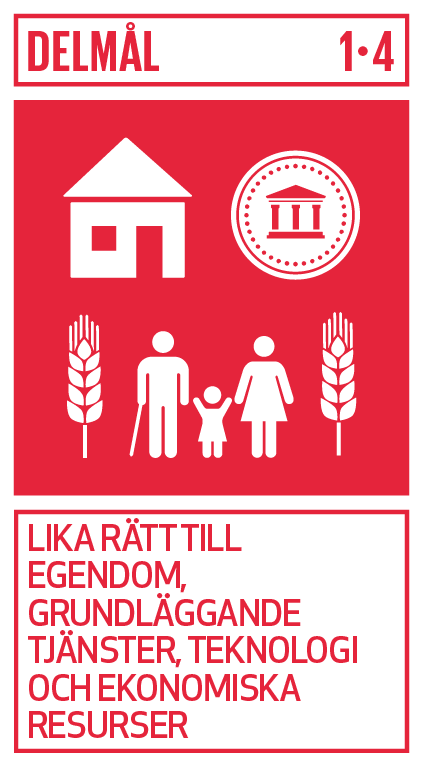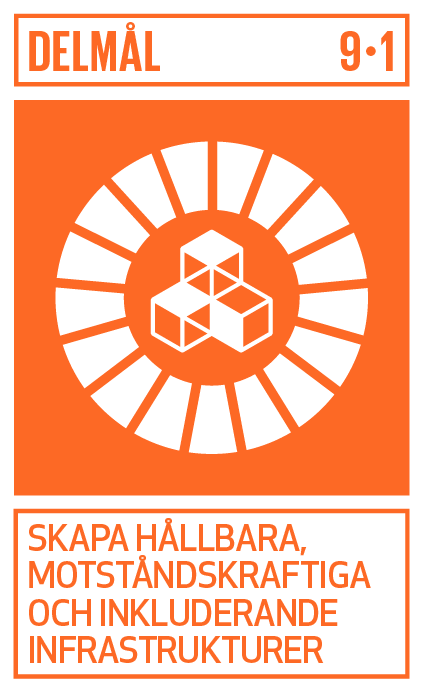Contents of this page may be automatically translated, we take no responsibility for the accuracy of the translation. Feel free to contact our customer support centre if you have any questions.

Lantmäteriet has a broad impact on Sweden's economy, for example, our property register is a central source for basic data, our operations contribute to secure property ownership and a stable economy and our geodata contributes, among other things to a more efficient societal development and the implementation of Agenda 2030 in Sweden.
Sub-goal 1.4
Sub-goal 1.4 means equal rights to property, basic services, technology and financial resources.
Through efficient, legally secure real estate development, Lantmäteriet creates the conditions for sustainable growth in the Swedish society. It lays the foundation for secure property ownership and contributes to a stable economy. Securing ownership is the basis for a market economy and a functioning credit market. This is obvious in Sweden but is missing in many parts of the world. Uncertain or no boundaries for real estate are a major source of concern and war in the world. Lantmäteriet secures Sweden's properties.
Lantmäteriet contributes to sub-goal 1.4 through its services in several ways:
- In case of uncertainty about where a property boundary goes, Lantmäteriet can make a legally binding decision on the location of the boundary through a boundary determination. Ownership is established and the property owner can use the property with the certainty that they do it on their own land.
- Lantmäteriet has registers of owners and holdings for all about 3.5 million properties in Sweden. This provides a legally secure and secure ownership and is a prerequisite for lending with real estate as security. Property owners can invest in their own property, as well as mortgage the property and use it as collateral for the investments.
- Lantmäteriet can also decide on community facilities that, among other things, cater the common needs of several properties for roads, water and broadband.
Sub-goal 9.1
Sub-goal 9.1 means creating sustainable, resilient and inclusive infrastructures. Infrastructure may, in addition to railways, roads or water and sewerage systems, include a national infrastructure for spatial data.
Lantmäteriet's work with the national infrastructure for geodata provides the necessary conditions for a number of activities. Knowledge of the landscape and natural conditions as well as built structures is a starting point for managing resources, community building, economic development, mapping of desired and undesirable phenomena and, in general, the development of a sustainable society.
Ensuring railways and roads
In the case of a new railway line, Lantmäteriet is involved in forming properties for this and can handle the entire matter with redemption of property and compensation. For wiring, Lantmäteriet can contribute to resolving the issue of the right to draw management over someone else's land and the issue of compensation through a management procedure for management rights. Lantmäteriet participates in large parts of the private road network (private road) by deciding on community facilities where it is decided how much each of the properties should participate in and pay for new construction and operation of
Major cost savings with GNSS technology
The national geodetic reference systems and access to Lantmäteriet's Swepos system for real-time corrections are important prerequisites for effective precision measurement at e.g. road and railway construction and other infrastructure investments.
In the Norrbotnia line (Umeå-Skellefteå) railway project, 15 new reference stations where network RTK is used have been set up for the Umeå-Dåva section. By using GNSS technology (network RTK) instead of traditional measurement, the Swedish Transport Administration has estimated cost savings of approximately SEK 650 million, where the largest savings consist of the use of GNSS technology on machines.



